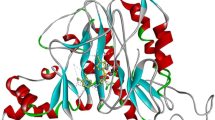Abstract
Methionine synthase (MetS) catalyses the transfer of a methyl group from the methyltetrahydrofolate (MTHF) to homocysteine to produce methionine and tetrahydrofolate. MetS is over-expressed in the cytosol of certain breast and prostate tumor cells. In this article, we designed, synthesized, and evaluated the biological activity of a series of substituted quinoxaline derivatives that mimic the MTHF in the structure. The main aim was to develop inhibitors that could inhibit the enzyme reaction by blocking the binding of MTHF. These inhibitors were docked into the MTHF binding domain in such the same way as MTHF in its binding domain. Compound 4-({(6-nitro-quinoxalin-2-yl)methylamino}methyl)benzoic acid showed the lowest free energy of the binding (−152.62 kJ/mol) and showed the lowest IC50 values of 45 ± 9 and 53 ± 9 μM against two types of cancer cell lines PC-3 and MCF-7, respectively.












Similar content being viewed by others
References
Cairns D, Michalitsi E, Terence C (2001) Molecular modeling and cytotoxicity of substituted anthraquinones as inhibitors of human telomerase. Bioorg Med Chem 10:803–807
Danishpajooh IO, Gudi T, Chen Y, Kharitonov VG (2001) Nitric oxide inhibits methionine synthase activity in vivo and disrupts carbon flow through the folate pathway. J Biol Chem 276:27296–27303
Halpern B, Clark B, Hardy D (1974) Effect of replacement of methionine by homocystine on survival of malignant and normal adult mammalian-cells in culture. Proc Natl Acad Sci USA 71:1133–1136
Hoffman R (1982) Methionine dependence in cancer-cells. A review. J Tissue Cult Assoc 18:421–428
Kenyon SH, Waterfield CJ, Timbrell JA (2002) Methionine synthase activity and sulphur amino acid levels in the rat liver tumour cells HTC and Phi-1. Biochem Pharmacol 63:381–391
Kitamura M, Yoshida M (2003) Synthesis of quinolines and 2H-dihydropyrroles by nucleophilic substitution at the nitrogen atom of oxime derivatives. Synthesis 15:2415–2426
Lawrence T, Scott A, Mark A (2006) A short new azulene synthesis. J Am Chem Soc 102:6311–6314
Majid M, Khadijeh B (2006) Facile synthesis of quinoxaline derivatives using o-iodoxybenzo acid (IBX) at room temperature. ARKIVOC xvi:16–22
Pavillard V, Nicolaou A, Double JA (2006) Methionine dependence of tumours: a biochemical strategy for optimizing paclitaxel chemosensitivity. Biochem Pharmacol 71:772–778
Tony W, Heping Y, Hui P, Meng X, José M (2011) Effects of S-adenosylmethionine and methylthioadenosine on inflammation induced colon cancer in mice. Carcinogenesis 33:427–435
Woo-Jin Y, Chao-Jun L (2006) Highly efficient oxidative amidation of aldehydes with amine hydrochloride salts. J Am Chem Soc 128:13064–13065
Yunzhen H, Qing X, Shihao S, Xiaowen L (2012) Synthesis and biological evaluation of 3-aryl-quinoxaline-2-carbonitrile 1,4-di-N-oxide derivatives as hypoxic selective anti-tumor agents. Molecules 17:9683–9696
Acknowledgments
My gratitude to Andrew Healy (University of Bradford, IPI) for measuring the mass spectra and to Dennis Farewell (University of Bradford, IPI) who had trained me on using NMR.
Author information
Authors and Affiliations
Corresponding author
Appendix: The free energy of binding
Appendix: The free energy of binding
Rights and permissions
About this article
Cite this article
Elshihawy, H., Hammad, M. Molecular modeling studies and synthesis of novel quinoxaline derivatives with potential anti-cancer activity as inhibitors of methionine synthase. Med Chem Res 22, 3405–3415 (2013). https://doi.org/10.1007/s00044-012-0307-4
Received:
Accepted:
Published:
Issue Date:
DOI: https://doi.org/10.1007/s00044-012-0307-4




